What is hydroponics?

Hydroponics- A newly practiced age old tradition
Aside from light, air, warmth and carbon dioxide, plants need water and nutrients for growth. Hydroponic systems deliver just that. It is an old practice that dates back to the Aztecs and Babylonians. The Aztecs referred to them as “floating” gardens. The term “hydroponics” was coined in the 1930’s by Dr. William F. Gericke of the University of California.
Hydroponics is a method of growing plants in a soil-less medium or an aquatic based environment. The medium can be a solution filled with nutrients or an inert growing medium such as sand or perlite. A hydroponic system is a structure such as a tray, A-frame or a tower that holds an inert medium or water and provides a place to grow plants. There are very many types of hydroponic systems but all of them have to ensure that the plants have access to oxygen, water and nutrients.
With hydroponics, farmers don’t have to stress over weeding, soil borne diseases, fertilizers and pesticides. This is because hydroponics creates a sterile environment for the crops. Pumping nutrients directly into the roots results in bigger and better results over short period of time. Hydroponics can be done both indoors and outdoors therefore you don’t have to worry about space. Hydroponic systems are good for the environment because they use less water than soil based farming. Hydroponic systems recycle water, hence, you don’t have to worry about environmental degradation caused by high concentration of nutrients (calcium, phosphorous and potassium) in the run off experienced in traditional farming.
The most obvious reason to have a hydroponic system is that they aren’t affected by changing seasons, therefore, you can farm all year round.However, the initial set up cost of a hydroponic system is high. In order to operate it, you need technical knowledge and constant supervision is required to ensure they are growing in the exact conditions they need.
Hydroponic systems are susceptible to power outage which results to plants drying out. In case of this scenario, you have to manually water your garden. However, there have been new technologies with solar which ensures the process isn’t interrupted by a power failure. Water-based microorganisms can also be easily introduced into the system. Hydroponic plants have much smaller root systems, hence, they can’t always support themselves very well. Heavy fruiting plants may need quite elaborate forms of support. I’d like to think that the advantages outweigh the disadvantages because they are things that can be easily manageable. If you think the price is too high, start small, and then build from there.
Urban farming is slowly catching up and hydroponic systems present a way in which you can earn money and eat fresh food from that small space in your house or on your piece of land.
Who knows, we might start selling these units soon.
Happy Planting!


